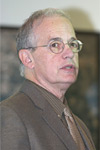Director's Corner
27 April 2006

Barry Barish
Elementary Particle Physics in the 21st Century
Creating a roadmap for the future of a scientific field has become a very important planning tool in research areas that require large instruments, such as astronomy and particle physics. This year, two new studies will play a very important role in how particle physics will develop in the future. A planning exercise directed at the future of European particle physics is underway by the CERN Council Strategy Group, and in the U.S. a study called EPP2010 has just been completed and their report was released yesterday.
The much awaited U.S. report is called "Revealing the Hidden Nature of Space and Time : Charting the Course for Elementary Particle Physics." It addresses the future opportunities in particle physics and gives recommendations for the U.S. program, in the context of the worldwide program.

Harold Shapiro
The U.S. report provides a large and welcome boost to our aspirations for the ILC: " The results of the committee's analysis have led to its chief recommendation. The United States should remain globally competitive in elementary particle physics by playing a leading role in the worldwide effort to aggressively study Terascale physics."
They follow by defining the priorities to implement their recommendation that included to " Plan and initiate a comprehensive program to become the world-leading center for research and development on the science and technology of a linear collider, and do what is necessary to mount a compelling bid to build the proposed International Linear Collider on U.S. soil." I hope that this very strong priority statement for the linear collider will be followed by similar priorities statements emerging from Europe and Asia.
Long range planning for high energy physics in the U.S. has traditionally been done through HEPAP, an agency advisory panel. The last such subpanel report, carried out in 2001 and chaired by Jon Bagger (JHU) and myself, helped to establish a TeV scale linear collider as the long term goal of our field, in conjunction with similar reports from Europe and Asia.
Last year, it was decided that planning for the role of elementary particle physics required a different kind of study, one carried out by the U.S. National Academy of Sciences (the "gold standard" for such reports in the US). The objective was to form a very broad committee that would do an overall assessment of the field, its prospects and lay out priorities for its future.
EPP2010 was chaired by Harold T. Shapiro, president emeritus and professor of economics and public affairs at Princeton University and was especially notable by both the prominence of its members and the unusual breadth of the committee, having members from many fields outside elementary particle physics, including some outside physics altogether.
I reported to EPP2010 twice and was very impressed by the seriousness and thoroughness of their study, which included trips to KEK, CERN and DESY. Their strong endorsement of the ILC represents a very important validation of our goals by prominent people inside and outside our field. Although the focus of this report was to make recommendations for the U.S. program in particle physics they endorsed the global approach we are following in the GDE, "The ILC has been an international effort from its inception and should continue to be pursued as a global venture."